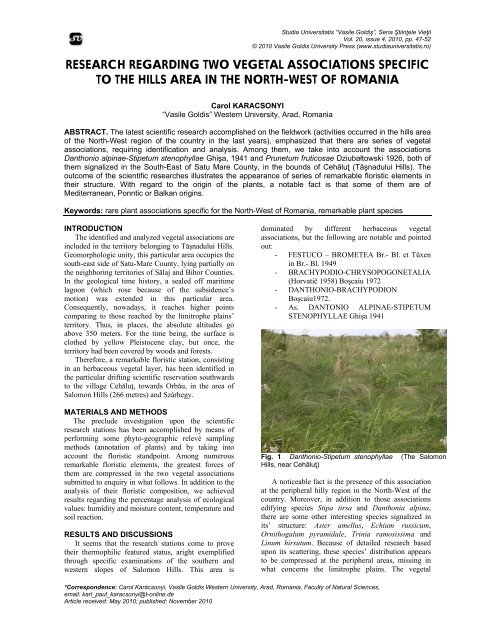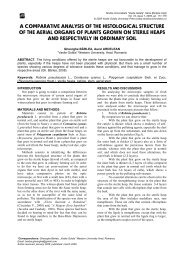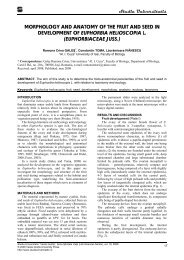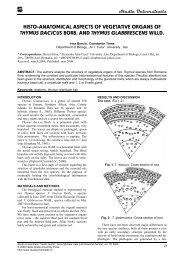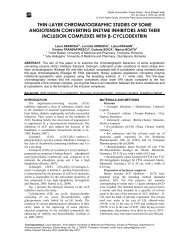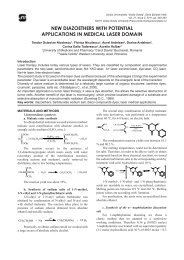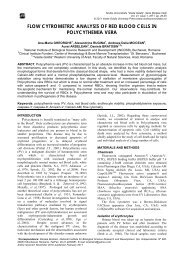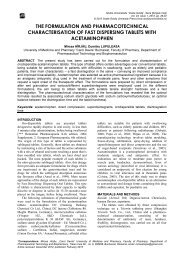Read full article - Studia Universitatis Vasile Goldis, Seria Stiintele ...
Read full article - Studia Universitatis Vasile Goldis, Seria Stiintele ...
Read full article - Studia Universitatis Vasile Goldis, Seria Stiintele ...
You also want an ePaper? Increase the reach of your titles
YUMPU automatically turns print PDFs into web optimized ePapers that Google loves.
<strong>Studia</strong> <strong>Universitatis</strong> “<strong>Vasile</strong> Goldiş”, <strong>Seria</strong> Ştiinţele Vieţii<br />
Vol. 20, issue 4, 2010, pp. 47-52<br />
© 2010 <strong>Vasile</strong> <strong>Goldis</strong> University Press (www.studiauniversitatis.ro)<br />
RESEARCH REGARDING TWO VEGETAL ASSOCIATIONS SPECIFIC<br />
TO THE HILLS AREA IN THE NORTH-WEST OF ROMANIA<br />
Carol KARACSONYI<br />
“<strong>Vasile</strong> <strong>Goldis</strong>” Western University, Arad, Romania<br />
ABSTRACT. The latest scientific research accomplished on the fieldwork (activities occurred in the hills area<br />
of the North-West region of the country in the last years), emphasized that there are series of vegetal<br />
associations, requiring identification and analysis. Among them, we take into account the associations<br />
Danthonio alpinae-Stipetum stenophyllae Ghişa, 1941 and Prunetum fruticosae Dziubałtowski 1926, both of<br />
them signalized in the South-East of Satu Mare County, in the bounds of Cehăluţ (Tăşnadului Hills). The<br />
outcome of the scientific researches illustrates the appearance of series of remarkable floristic elements in<br />
their structure. With regard to the origin of the plants, a notable fact is that some of them are of<br />
Mediterranean, Ponntic or Balkan origins.<br />
Keywords: rare plant associations specific for the North-West of Romania, remarkable plant species<br />
INTRODUCTION<br />
The identified and analyzed vegetal associations are<br />
included in the territory belonging to Tăşnadului Hills.<br />
Geomorphologic unity, this particular area occupies the<br />
south-east side of Satu-Mare County, lying partially on<br />
the neighboring territories of Sălaj and Bihor Counties.<br />
In the geological time history, a sealed off maritime<br />
lagoon (which rose because of the subsidence’s<br />
motion) was extended in this particular area.<br />
Consequently, nowadays, it reaches higher points<br />
comparing to those reached by the limitrophe plains’<br />
territory. Thus, in places, the absolute altitudes go<br />
above 350 meters. For the time being, the surface is<br />
clothed by yellow Pleistocene clay, but once, the<br />
territory had been covered by woods and forests.<br />
Therefore, a remarkable floristic station, consisting<br />
in an herbaceous vegetal layer, has been identified in<br />
the particular drifting scientific reservation southwards<br />
to the village Cehăluţ, towards Orbău, in the area of<br />
Salomon Hills (266 metres) and Szárhegy.<br />
MATERIALS AND METHODS<br />
The preclude investigation upon the scientific<br />
research stations has been accomplished by means of<br />
performing some phyto-geographic relevé sampling<br />
methods (annotation of plants) and by taking into<br />
account the floristic standpoint. Among numerous<br />
remarkable floristic elements, the greatest forces of<br />
them are compressed in the two vegetal associations<br />
submitted to enquiry in what follows. In addition to the<br />
analysis of their floristic composition, we achieved<br />
results regarding the percentage analysis of ecological<br />
values: humidity and moisture content, temperature and<br />
soil reaction.<br />
RESULTS AND DISCUSSIONS<br />
It seems that the research stations come to prove<br />
their thermophilic featured status, aright exemplified<br />
through specific examinations of the southern and<br />
western slopes of Salomon Hills. This area is<br />
dominated by different herbaceous vegetal<br />
associations, but the following are notable and pointed<br />
out:<br />
- FESTUCO – BROMETEA Br.- Bl. et Tüxen<br />
in Br.- Bl. 1949<br />
- BRACHYPODIO-CHRYSOPOGONETALIA<br />
(Horvatič 1958) Boşcaiu 1972<br />
- DANTHONIO-BRACHYPODION<br />
Boşcaiu1972.<br />
- As. DANTONIO ALPINAE-STIPETUM<br />
STENOPHYLLAE Ghişa 1941<br />
Fig. 1 Danthonio-Stipetum stenophyllae (The Salomon<br />
Hills, near Cehăluţ)<br />
A noticeable fact is the presence of this association<br />
at the peripheral hilly region in the North-West of the<br />
country. Moreover, in addition to those associations<br />
edifying species Stipa tirsa and Danthonia alpina,<br />
there are some other interesting species signalized in<br />
its’ structure: Aster amellus, Echium russicum,<br />
Ornithogalum pyramidale, Trinia ramosissima and<br />
Linum hirsutum. Because of detailed research based<br />
upon its scattering, these species’ distribution appears<br />
to be compressed at the peripheral areas, missing in<br />
what concerns the limitrophe plains. The vegetal<br />
*Correspondence: Carol Karácsonyi, <strong>Vasile</strong> <strong>Goldis</strong> Western University, Arad, Romania, Faculty of Natural Sciences,<br />
email: karl_paul_karacsonyi@t-online.de<br />
Article received: May 2010; published: November 2010
Karacsonyi C.<br />
association is mainly dominated by Hemicryptophytes<br />
(68,3%), followed by Therophytes (13,6%),<br />
emphasizing, therefore, the station’s herbaceous status.<br />
From the standpoint of its’ geographical origin, besides<br />
Eurasian elements (45,7%), some species of Ponntic<br />
origin are distinguishing themselves in a considerable<br />
percentage (10,5%), respectively, Mediterranean origin<br />
(10,5%). As a consequence, the result is evincing the<br />
analyzed stations’ thermophilic character. With regard<br />
to the ecological values, the most species are making<br />
part of the Xeromesophytes (47,0%, humidity) of the<br />
Mesotherms (30,3%, temperature), respectively, of<br />
species indicating a poorly acid-neutrophyle soil<br />
(57,6%, soil reaction).<br />
A notable fact is that this specific vegetal<br />
association has already been succinct illustrated, by<br />
means of one certain relevé sampling method<br />
(annotation of plants) (Karácsonyi, 2002).<br />
The spectrum regarding the bioform: H - 68,3%/H<br />
(G) -1,5%; H (Ch) -1,5 %; H-G-1,5%; G-6%/G-H-<br />
3%; Ch 3%/Ch-H-1,5% ; T-13,6%/Th-9,1%; Th-3%;<br />
TH-H-1,5%; Ph-9,1%/Phm-3,0%; Phn-6,1%.<br />
The spectrum regarding the floristic elements: Eua-<br />
45,7%/Eua(C)-16,8% ; Eua(M)-7,5% ;E-16,7%/E(C)-<br />
3,0% ; Ec-9,1%/Ec(M)-1,5% ; Ec-M-1,5% ; Cp-1,5% ;<br />
M-10,5%/M-Ec-3.0% ; Atl-M-1,5% ; P-10,5% ; P-M-<br />
4,5% ; P-Pan-3,0% ; P-Pan-Ba-1,5% ; Ba-Pan-3,0% ;<br />
Cosm-1,5%.<br />
The relevé sampling method’s place and date:<br />
Cehăluţ, sampling 1 – Szárhegy 16-VI-1986: sampling<br />
-5 The Salomon Hill, 16 V 2009. (registred in VII<br />
2009).<br />
As. Danthonio alpinae-Stipetum stenophyllae Ghişa, 1941<br />
Bioform Floristic<br />
Number of relevé method 1 2 3 4 5<br />
element Species<br />
Surfa e (m² ) 25 25 25 20 20<br />
Plant dispersal(%) 95 100 95 95 90<br />
Slope S S-V S-V S-V S-V<br />
Inclination (degree) 15 15 8 10 8<br />
K<br />
DANTHONIO-STIPION TIRSAE<br />
H Eua (C) Stipa tirsa 4 4 4 5 4 V<br />
H M Danthonia alpina + + 1 1 + V<br />
DANTHONIO-BRACHYPODION<br />
H Ec Veronica austriaca ssp.bihariensis - + + - + III<br />
H Eua (M) Brachypodium pinnatum - + + + - III<br />
H Ba-pan Trinia ramosissima - + - - - I<br />
FESTUCO-BROMETEA<br />
H Eua (C) Festuca rupicola 2 1 + - + IV<br />
H Eua (C) Festuca valesiaca 1 - + + - III<br />
H P-pan Inula ensifolia + + - - 1 III<br />
Ch Eua (C) Thymus pannonicus + - + + + IV<br />
TH-H Eua Verbascum chaixii ssp.austriacum + - - - - I<br />
H E(M) Salvia pratensis + + - - + III<br />
H Eua (C) Trifolium montanum + + + + + V<br />
H E Dianthus carthusianorum + - - - - I<br />
H E Dianthus pontederae - - + - + II<br />
H P-M Veronica spicata ssp.orchidea + - - - - I<br />
Th P-M Odontites lutea 1 + - - - II<br />
TH Ec Seseli annuum + - - - - I<br />
H Eua Agrimonia eupatoria + - - + + III<br />
H Eua Filipendula vulgaris + + + + + V<br />
H Eua Plantago media + - - - - I<br />
H Eua(C) Aster amellus + - - - - I<br />
H Eua(C) Euphorbia virgata + - - - - I<br />
H Eua Euphorbia esula - - + + - II<br />
H P-Pan Echium russicum + - - - - I<br />
H P-M Asperula cynanchica + + - - + III<br />
H Ec Galium eruptivum - + + - - II<br />
Th Eua Bromus hordeaceus - + - - - I<br />
H(Ch) Eua Polygala comosa - + + + - III<br />
H P-Pan-Ba Linum hirstum - + - - - I<br />
H Eua(C) Hieracium bauhinii - - + + - II<br />
H Eua(C) Euphorbia cyparissias - - + + + III<br />
H Cp Koeleria macrantha - - + + + III<br />
Th M-Ec Valerianella locusta - - - - + I<br />
Th E(C) Melampyrum arvense - - + + - II<br />
G-H Eua(C) Poa bulbosa - - + - - I<br />
48<br />
<strong>Studia</strong> <strong>Universitatis</strong> “<strong>Vasile</strong> Goldiş”, <strong>Seria</strong> Ştiinţele Vieţii<br />
Vol. 20, issue 4, 2010, pp. 47-52<br />
© 2010 <strong>Vasile</strong> <strong>Goldis</strong> University Press (www.studiauniversitatis.ro)
The immunohistochemical detection of substance P (SP) in the pancreas and<br />
intestine of three species of lower vertebrates; light-microscopic observations<br />
H E Potentilla cinerea - - + - - I<br />
H P Eryngium campestre - - - + + II<br />
Th P-M Xeranthemum cylindraceum - - - - + I<br />
G-H Ec Thesium linophyllon + + + + + V<br />
GERANION SANGUINEI<br />
H E Geranium sanguineum - - - + + II<br />
H E(M) Peucedanum cervaria + + + - + IV<br />
H Eua Inula salicina + - + - - II<br />
Ch-H Ec(M) Dorycnium pentaphylum ssp. herbaceum + - + + - III<br />
H E(C) Fragaria viridis + - + + - III<br />
H Eua(C) Thalictrum minus + - - - - I<br />
H Ec-M Trifolium rubens + - + - - II<br />
H Eua(M) Vicia tenuifolia + + - - - II<br />
H M-Ec Prunella laciniata + - - - - I<br />
Phn M Rosa gallica + + + - - III<br />
H Eua(M) Centaurea scabiosa + - - - + II<br />
ORIGANETALIA<br />
H Eua Galium verum + - - - + II<br />
H M Lathyrus latifolius + - + - - II<br />
H E Hieracium sabaudum + - - - - I<br />
VARIAESYNTAXA<br />
G M Ornithogalum pyramidale + - - - - I<br />
H Eua Silene nutans - - + - - I<br />
G Eua(M) Carex tomentosa - + - - - I<br />
H Eua Leucanthemum vulgare - - + - - I<br />
H Eua Lotus corniculatus - - + - - I<br />
Th Atl-M Lathyrus nissolia - - - - + I<br />
H(G) Eua Calamagrostis epigeios + - + + + IV<br />
H-G Cosm Convolvulus arvensis + - - - - I<br />
Phn M Rubus canescens - - + - - I<br />
Phn Eua(C) Prunus fruticosa - - 1 - - I<br />
Phm Eua Prunus spinosa - + + - - II<br />
Phn E Rosa canina - + + - - II<br />
Phm E Crataegus monogyna - - + - + II<br />
50<br />
45<br />
40<br />
35<br />
30<br />
25<br />
20<br />
15<br />
10<br />
E u a ; 4 5 , 7<br />
E u a ; 1 6 , 7<br />
E c ; 9 , 1<br />
C p ; 1<br />
M ; 1 0 , 5<br />
A t l - M ; 1<br />
P ; 1 0 , 5<br />
;<br />
Fig. 2 The spectrum regarding the bioforms of the<br />
association Danthonio alpinae-Stipetum stenophyllae<br />
Fig. 3 The spectrum regarding the floristic elements of the<br />
association Danthonio alpinae-Stipetum stenophyllae<br />
<strong>Studia</strong> <strong>Universitatis</strong> “<strong>Vasile</strong> Goldiş”, <strong>Seria</strong> Ştiinţele Vieţii<br />
Vol. 20, issue 4, 2010, pp.47-52<br />
© 2010 <strong>Vasile</strong> <strong>Goldis</strong> University Press (www.studiauniversitatis.ro)<br />
49
Karacsonyi C.<br />
Fig. 4 The ecological values’ diagram of the species from<br />
the association Danthonio alpinae-Stipetum stenophyllae<br />
RHAMNO – PRUNETALIA Rivas Goday et Borja<br />
Carbonell, 1961<br />
PRUNETALIA SPINOSAE R. Tüxen, 1952<br />
Prunion fruticosae R. Tüxen, 1952<br />
As. Prunetum fruticosae Dziubałtowski,1926. This<br />
remarkable vegetal association is dominated by a low<br />
shrub species, named Prunus fruticosa, which forms a<br />
cluster of bushes and shrubs on the south-west slopes<br />
of Salomon Hills, near Cehăluţ (Satu Mare County).<br />
Besides the presence of the before mentioned shrub<br />
species, some herbaceous plants (particular for more<br />
worm and drier research stations) have appeared in this<br />
region (Cl. Festuco – Brometea). We also notice the<br />
existence of species characteristic for the extremity<br />
edge of the forest (Geranion sanguinei). Particularly<br />
for the scientific station, this is a sign with regard to the<br />
formerly vegetation’s mosaic composition. The<br />
herbaceous species characterized by high constancy<br />
Fig. 5 Prunus fruticosa on The Salomon Hill (near Cehăluţ).<br />
values of spreading and dispersal distribution are<br />
Danthonia alpina, Filipendula vulgaris, Thymus<br />
pannonicus, Fragaria viridis and the invasive element<br />
Calamagrostis epigeios. For the time being, in the<br />
spectrum regarding the bioform, the largest amount of<br />
percentage is registered by Hemicryptophytes (H –<br />
62.7%) in spite of the fact that the association’s<br />
edifying and dominating species are the<br />
Phanerophytes. From the standpoint of the constitutive<br />
species’ origin, the Mediterranean ones are<br />
distinguishing between them, because of its relatively<br />
high percentage (12.5%), in addition the dominating<br />
ones, the Eurasians (50%). The outcome of the<br />
scientific researches illustrates that according to the<br />
ecologic values, the most edifying and clear percentage<br />
is registered by: humidity - Xeromesophytes (57.5%),<br />
temperature – Mesotherms (37.5%), soil reaction –<br />
species poorly acid-neutrophyle (47.5%).<br />
As. Prunetum fruticosae Dziubałtowski, 1929<br />
Bioform<br />
Floristic<br />
element<br />
Species Number of relevé method 1 2 3 4 5<br />
Surface (m² ) 20 20 25 25 25<br />
Plant dispersal(%) 90 95 100 95 95<br />
Slope S- S- S-V S- S-V<br />
V V<br />
V<br />
Inclination (degree) 10 10 10 15 15<br />
K<br />
CHAR. ASS.<br />
Phn Eua(C) Prunus fruticosa 4 4 5 4 4 V<br />
Phn E Crataegus monogyna + 1 + - - III<br />
PRUNION SPINOSAE<br />
Phm Eua Prunus spinosa 2 + - - + III<br />
50<br />
<strong>Studia</strong> <strong>Universitatis</strong> “<strong>Vasile</strong> Goldiş”, <strong>Seria</strong> Ştiinţele Vieţii<br />
Vol. 20, issue 4, 2010, pp. 47-52<br />
© 2010 <strong>Vasile</strong> <strong>Goldis</strong> University Press (www.studiauniversitatis.ro)
The immunohistochemical detection of substance P (SP) in the pancreas and<br />
intestine of three species of lower vertebrates; light-microscopic observations<br />
Phn E Rosa canina - + + + - III<br />
Phn M Rubus canescens - - - + + II<br />
GERANION SANGUINEI<br />
H E(M) Geranium sanguineum + - - - + II<br />
H E(C) Fragaria viridis + - - + + III<br />
H Eua(M) Peucedanum cervaria + - - + + III<br />
Ch-H Ec-M Dorycnium pentaphyllum ssp.<br />
- + - - - I<br />
herbaceum<br />
H E(M) Trifolium alpestre - + - - - I<br />
H Eua(M) Vicinia tenuifolia + + - - - II<br />
Phn M Rosa gallica 1 - - - + II<br />
ORIGANETALIA<br />
H Eua Galium verum - + + - + III<br />
H Eua Hypericum perforatum - + - - + II<br />
H M Lathyrus latifolius - - - - + I<br />
FESTUCETALIA VALESIACAE<br />
H Eua(C) Festuca valesiaca - - + - - I<br />
H Eua(C) Festuca rupicola - + - - + II<br />
Ch Eua(C) Thymus pannonicus + + + + - IV<br />
Th E(C) Melampyrum arvense - + - - + II<br />
G-H Ec Thesium linophylon - + + - - II<br />
H Ba-Pan Dianthus pontederae - - + + - II<br />
H Eua Sanguisorba minor - - + - - I<br />
Th Atl-M-Ec Vicia lathyroides - - + - - I<br />
Th M-Ec Valerianella locusta - - - - + I<br />
Phn Eua(C) Chamaecytisus ratisbonenensis + - - - - I<br />
H Eua(C) Hieracium bauhinii + - - - - I<br />
FESTUCO-BROMETEA<br />
H Cp Koeleria macrantha 1 + + + + V<br />
H Eua Filipendula vulgaris + - + + + IV<br />
H(Ch) Eua Polygala comosa + + - - - II<br />
H Eua(C) Trifolium montanum + - + - + III<br />
Th-TH E Trifolium campestre - - - - + I<br />
H-G Eua Euphorbia cyparissias + - - - - I<br />
H P Eryngium campestre - - - + + II<br />
H Eua(C) Stipa tirsa - + + - - II<br />
H M Danthonia aplina + + - + + IV<br />
VARIASYNTAXA<br />
H E Silene nutans - - - + + II<br />
H Eua Euphorbia esula + + - - + III<br />
G Eua(M) Carex tomentosa + + - - - II<br />
H E Leucanthemum vulgare + - + - - II<br />
H(G) Eua(M) Calamagrostis epigeios + + + + + V<br />
60<br />
50<br />
50<br />
40<br />
30<br />
22,5<br />
20<br />
12,5<br />
10<br />
5<br />
2,5<br />
2,5 2,5<br />
Fig. 6 The spectrum regarding the bioforms of the<br />
association Prunetum fruticosae<br />
<strong>Studia</strong> <strong>Universitatis</strong> “<strong>Vasile</strong> Goldiş”, <strong>Seria</strong> Ştiinţele Vieţii<br />
Vol. 20, issue 4, 2010, pp.47-52<br />
© 2010 <strong>Vasile</strong> <strong>Goldis</strong> University Press (www.studiauniversitatis.ro)<br />
0<br />
Eua E Ec Cp M Atl - P<br />
Fig. 7 The spectrum regarding the floristic elements of<br />
the association Prunetum fruticosae<br />
51
Karacsonyi C.<br />
The spectrum regarding the bioform: H – 62.7%/ H<br />
(Ch) -2.5%; H-G-2.5%; Ch-5%; / Ch-H-2.5%; T-10% /<br />
Th-7.5%; Th-TH-2.5%; Ph-17.5% / Phm-5.4%; Phn-<br />
12.5%.<br />
The spectrum regarding the floristic elements: Eua-<br />
50%/Eua(C)-20% ; Eua(M)-7.5% ;E-22.5%/E(C)-<br />
5.0%; E(M)-7.54% ; Ec-5%/Ec(M)-2.5% ; Cp-2.5% ;<br />
M-12.5%/M-Ec-2.5% ; Atl-M-Ec-2.5% ; P-2.5% ; Ba-<br />
Pan-2.5% .<br />
The relevé sampling method’s place and date:<br />
Cehăluţ, The Salomon Hills, 16 V 2009. This rare<br />
association has been analysed especially in The East<br />
and The South of Romania (Sanda et al., 2088).<br />
Doniţă N., Popescu A., Paucă Comănescu Mihaela,<br />
Mihăilescu Simona, Biriş I. – A., Habitatele din<br />
România, Editura Tehnică, Bucureşti, 2005.<br />
Ghişa E., Cercetări asupra As. Stipetum stenophyllae –<br />
Danthoniteum calycinae în Transilvania, Bul.<br />
Grăd. Bot. Muz. Bot. Cluj, 21, 1941, 1-2, 56-67.<br />
Karácsonyi C., Flora şi vegetaţia judeţului Satu Mare,<br />
Edit. Muzeului Sătmărean, Satu Mare, 1995.<br />
Karácsonyi C., Die Trockenarasen an der kollinen<br />
Stufe im Nordwesten Siebenbürgens,<br />
Siebenbürgisches Archiv, 36, Naturwiss.<br />
Forschungen über Siebenbürgen, VI, Köln-<br />
Wien-Weimar, 2000. 177-193.<br />
Sanda V., Öllerer Kinga, Burescu P., Fitocenozele din<br />
România, Sintaxonomie, structură, dinamică şi<br />
evoluţie, Edit. Ars Docendi, Bucureşti, 2008.<br />
Schneider-Binder Erika, Pajişti xeromezofile din<br />
Depresiunea Sibiului şi colinele ei marginale,<br />
Şt. Com., Şti. Nat., Muz Brukenthal, Sibiu, 16,<br />
1971, 135-172.<br />
Schneider-Binder Erika, Gebüsche und Hecken<br />
(Prunion fruticosae Tx. 1952 und Prunion<br />
spinosae Soó (1930 n.n. 1940) im Hügelgebiet<br />
und die Zibinsenke in Siebenbürgen, St.<br />
Com.Şti. Nat., Muz. Brukenthal, Sibiu, 17,<br />
1972, 183-207.<br />
Fig. 8 The ecological values’ diagram of the species<br />
from the association Prunetum fruticosae<br />
CONCLUSIONS<br />
The outcome of the scientific flora and vegetation<br />
researches accomplished in the perimeter of Tăşnadului<br />
Hills illustrates that the station from Cehăluţ is unique<br />
in the area, on account of it’s preservation in a<br />
increasing number of remarkable thermophile species<br />
of plants. In times to come, these species’ persistency<br />
may endanger the clusters of shrubs’ extension and the<br />
invasion of first-rate species, as Calamagrostis<br />
epigeios, in addition to the negative influence<br />
considering the human activities. To conclude, in order<br />
to maintain the area’s genuine specificity, we propose<br />
its inclusion on the list of natural reservations in<br />
Romania.<br />
REFERENCES<br />
Borhidi A., Magyarország növénytársulásai,<br />
Akadémiai Kiadó, Budapest, 2003.<br />
Coldea G., Sanda V., Popescu A., Ştefan N., Les<br />
associations végétales de Roumanie, Tom 1, Les<br />
associations herbacées naturelles, Presses<br />
Universitarie de Cluj, Cluj-Napoca, 1997.<br />
52<br />
<strong>Studia</strong> <strong>Universitatis</strong> “<strong>Vasile</strong> Goldiş”, <strong>Seria</strong> Ştiinţele Vieţii<br />
Vol. 20, issue 4, 2010, pp. 47-52<br />
© 2010 <strong>Vasile</strong> <strong>Goldis</strong> University Press (www.studiauniversitatis.ro)


